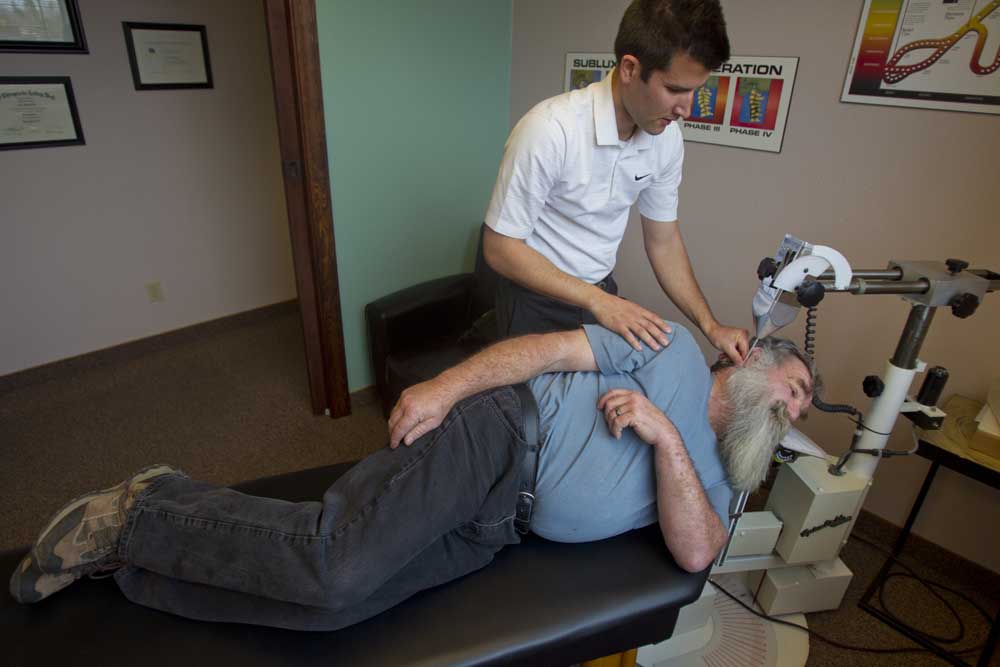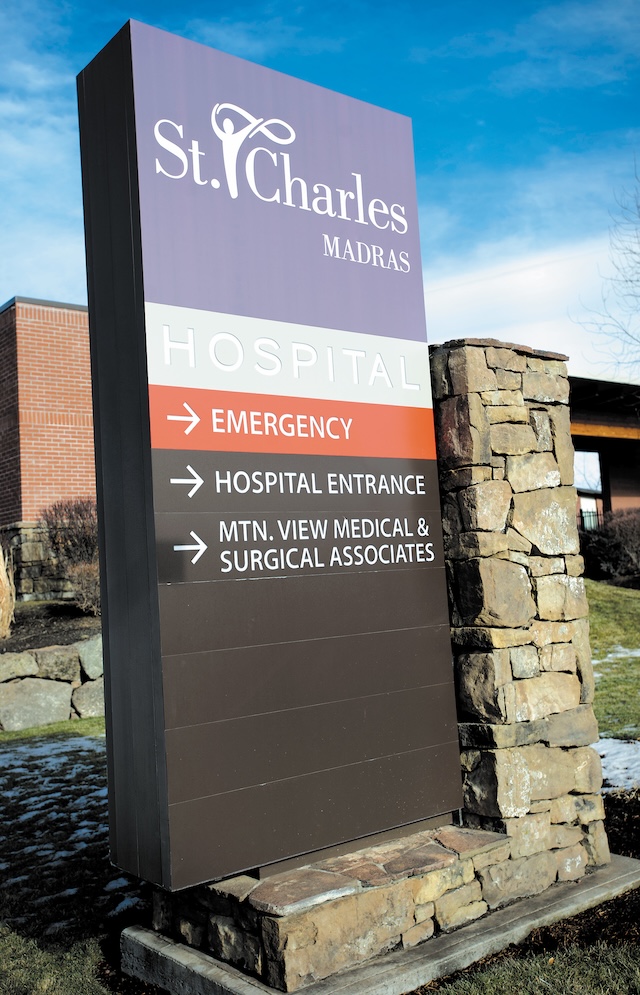Bend clinic touts headache cure, draws skeptics
Published 12:00 am Thursday, May 1, 2014

- Andy Tullis / The Bulletin Dr. Ian Sheppard, a chiropractor, uses the Atlas Orthogonal percussion device on Dennis Crow, 62, of La Pine, who visits Sheppard two to three times a week for this treatment at Oregon Head & Neck in Bend.
A pair of chiropractors who moved from Washington state to open a new clinic in Bend hope to appeal to quite a large group of potential patients: anyone with chronic headaches or migraines who haven’t been able to find relief through the traditional routes.
Ian Sheppard and Jeffry Finnigan, co-owners of Oregon Head & Neck, have a unique way of treating such ailments, one most people have never heard of: Atlas Orthogonal procedures.
Trending
Based on the premise that some headaches and migraines are caused by a misaligned atlas, the uppermost cervical vertebra, their machine sends percussion waves into the neck from a needle-like tube placed just below the ear. The waves are meant to take pressure off the nerves and blood vessels and slowly move the bone back into the proper spot.
Finnigan, whose book “Life Beyond Headaches” describes the technique and includes several testimonials from former patients, said headache and migraine sufferers are understandably frustrated.
“They’ve been told by their doctors, ‘Sorry, you’re going to have to swallow these pills for the rest of your life. Just suck it up and swallow these chemicals,’” he said. “We’re here because we want to offer hope.”
It only takes a split second for the machine to produce the wave — which sounds like an eye doctor’s air-puff glaucoma test — so a typical appointment takes only 10 to 15 minutes. But even one visit has been enough to produce results in some patients, said Sheppard, who will provide most of the patient care at the clinic, which he and Finnigan say is the first in Central Oregon to use the Atlas device.
“I’ve seen cases where they can get dramatic relief — not a total resolution of their ailment in the first visit — but they go, ‘Wow, something positive changed here,’” he said.
Issues up north
Trending
Before coming to Bend, Finnigan offered Atlas Orthogonal procedures for decades at a clinic he owned in Lacey, Wash., a suburb of Olympia. There, he was the subject of about 20 complaints since 1987, including for fraud, unprofessional advertising, questionable conduct, unprofessional, unauthorized excess services and fee disputes, according to documents provided by the Washington State Department of Health. The Bulletin was not able to obtain the full case reports as of press time.
At least five cases were closed because there was no cause for action.
Finnigan’s chiropractic license in Washington state still is “active with conditions” following violations stemming from patient care in 2010 and 2011. With eight of his patients, Finnigan provided insufficient patient records to justify the bills he submitted to health insurance companies, according to the Washington State Department of Health. Another patient did not receive a physical exam, had improper X-rays taken, received no reflex testing after reporting arm and leg numbness and no orthopedic testing for a compromised nerve root. Patients also reported motion testing that did not correlate with their symptoms.
The billing issues were the result of a new staff person who handled some things inappropriately, Finnigan said. In another case, a patient thought she was entitled to free services but was not, he said.
“I’ve had like three or four different stubs of your toe,” Finnigan said, “and when you deal with 20,000 people over 30 years, somebody is going to get their nose bent somewhere along the line.”
Ultimately, Finnigan said the decision to sell Finnigan Chiropractic in December and move to Bend was “because I wanted to get out of the rain, and I was ready for a change.”
Skeptical neurologist
Scan the Internet for information on Atlas Orthogonal procedures, and you’ll find claims from clinics across the country that offer the services.
You might find the YouTube video of a 2008 talk show segment in which host Montel Williams, who suffers from multiple sclerosis, calls Atlas Orthogonal, “the most amazing thing that ever happened to me.”
What you won’t find, however, is mention of it on most well-known medical websites or academic research portals.
Major health insurance companies like Regence BlueCross Blue Shield of Oregon, Moda, LifeWise and Health Net classify it as “investigational” and don’t cover it.
Neurologist Peter Goadsby, director of the University of California, San Francisco’s Headache Center and a world-renowned expert on headaches and migraines, said the term “headache” is so broad he’s skeptical of any clinic that claims to treat them. Headaches are either caused by some other problem — an infection or tumor, for example — or they are themselves the problem. Migraines, an inherited disorder, fall under the latter category, he said.
“The statement ‘I can do something for headaches’ is as ridiculous as saying, ‘I have a pair of shoes for all men,’” Goadsby said. “It’s too broad, to me, and I would say it’s broad to the point of being careless.”
Goadsby said he’s never heard of a misaligned atlas causing migraines.
“I know of no plausible basis to link misalignment of the atlas on the axis in migraine,” he said. “If you think you becoming president sounds silly, what you’re describing to me that the chiropractors are doing to patients with migraines sounds more silly to me than becoming president.”
Goadsby said ever since he became interested in headaches, he’s seen chiropractors claiming they could help rid patients of them, but has never seen evidence that that’s true. The most important thing for a headache sufferer to do is to get a proper diagnosis, he said.
One thing is for sure: Those struggling with headaches and migraines do need better treatments than are currently available, Goadsby said. Sufferers who have tried a number of therapies tend to eventually buy into treatments that haven’t been properly evaluated, he said.
“I see what happens: A person is desperate, they get caught up in a situation and they’ll do anything that they can do to try and control the headaches, particularly with migraines,” Goadsby said. “It’s not just with this device.”
Happy customer
Shortly after moving to Bend last May, Debbie Seibert took a trip to Chicago with her daughters. There, she came down with a headache so bad, she went to the emergency room. A doctor blamed stress and gave her pain pills.
Back in Bend, the 58-year-old saw a massage therapist but left the appointment in tears from the pain. The masseuse recommended a chiropractor who had helped previous clients: Ian Sheppard.
Seibert was skeptical at first, having previously worked in health insurance, an industry she said tends to frown upon chiropractors, but gave it a shot anyway.
After only two treatments with the Atlas Orthogonal device, Seibert said she was pain-free.
“The problem was gone,” she said. “It hasn’t come back.”
Just as every patient’s misalignment is unique, Sheppard and Finnigan said, so is the amount of adjustments they’ll require before their pain is gone.
Because of that, Finnigan said it’s also hard to say how much the overall treatment will cost. The price tag could be anywhere from a few hundred dollars to a few thousand, depending on the patient’s severity. A single adjustment costs $70 to $100, he said, but anyone can get an initial consultation free of charge.
To determine if the Atlas technique would be appropriate for potential patients, Sheppard and Finnigan first study X-rays of their upper cervical spines, looking for the misaligned atlas.
Using an anonymous patient’s X-rays as an example, Sheppard demonstrated how once the images are loaded into the clinic’s software, he gets a calculation of how the patient’s head is balanced on her spine before and after treatment.
The key to the adjustments, he said, is creating just the right formula for each patient. He then plugs the formula into the Atlas device, which delivers just the right wave at just the right angle. Orthogonal is a geometric term that refers to a 90-degree angle, which — when one’s atlas is aligned — would be the angle between a patient’s head and neck.
“If you can come in as precisely as possible, you can move and reduce that misalignment without a real forceful input of energy, if you’re as precise as we’re trying to be,” Sheppard said.
The U.S. Food and Drug Administration originally approved the Atlas Orthogonal Percussion Instrument in 1995. It was developed by chiropractor Roy Sweat, whom Sheppard called in his book dedication “my friend, my brother, and my mentor.”
In the past, Goadsby said, FDA device approvals hinged more on whether the developer could prove it’s safe rather than whether it works. He said he wasn’t sure whether that was the case with the Atlas device A request for information to the FDA didn’t yield a response by press time.
The FDA’s device approval process is far less rigorous than that of drugs, according to a 2011 study in the Journal of Managed Care Pharmacy. Most devices enter the market by having proven equivalence to a previously approved device, which secures the notion that it is reasonably safe and does what it’s intended to do, the study said.
According to the study, no demonstration of efficacy is required for device approval, resulting in products that “have little benefit over existing services or, worse, that they offer no benefit at all.”
In Goadsby’s mind, that’s an important nuance, as people tend to automatically think if the FDA approves a device, that means the agency thinks it works, he said.
But, according to Sheppard and Finnigan, there’s no doubt that the Atlas device works. In 90 percent of cases, Sheppard said patients see a partial or total reduction in their symptoms.
Seibert, a skeptic at first, is now among the clinic’s believers. “I was extremely impressed by it,” she said. “I don’t want to take pain pills. I’m on enough medication.”
— Reporter: 541-383-0304,
tbannow@bendbulletin.com








